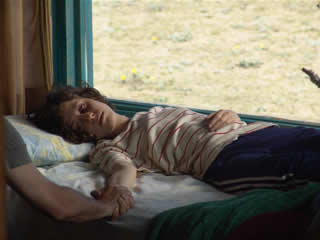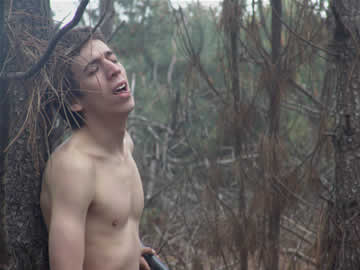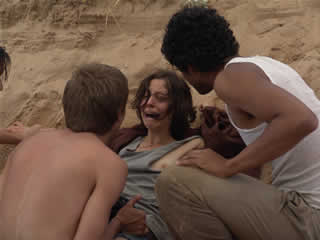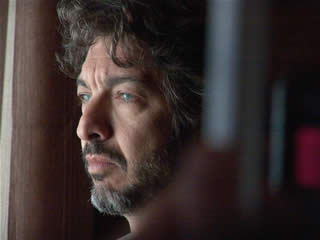XXY is about Alex is a 15-year-old teenager with a secret. Soon after her birth her parents decide to leave Buenos Aires to make a home out of an isolated wooden cabin tucked away in the dunes of the Uruguayan shoreline.
XXY begins with Alex´s parents receiving a couple of friends and their 16-year-old son Álvaro from Buenos Aires. Álvaro´s father is a plastic surgeon who accepted the invitation because of his medical concern for their friend´s daughter. The inevitable attraction between both teenagers forces them all to face their worst fears… Rumours are spreading around town. Alex gets stared at as if she were a freak. People´s fascination with her can become dangerous.
Lucia Puenzo was born in Buenos Aires, Argentina, in 1976. She published the novels El Niño Pez (Beatriz Viterbo, Tusquets, 2004), 9 minutos (Beatriz Viterbo, Tusquets, 2005) and La Maldición de Jacinta Pichimahuida (Interzona, 2007). XXY, her first feature length film, received the support of the Cinéfondation, Fond Sud, INCAA and ICAA. She has also directed short films, documentaries and the telefilm Los Invisibles.
Viterbo, Tusquets, 2005) and La Maldición de Jacinta Pichimahuida (Interzona, 2007). XXY, her first feature length film, received the support of the Cinéfondation, Fond Sud, INCAA and ICAA. She has also directed short films, documentaries and the telefilm Los Invisibles.
Cinema Without Borders: XXY is a daring and unusual film, what inspired you to make this film?
Lucia Puenzo: XXY is based on a short story called “Cinismo”, from the Argentine writer Sergio Bizzio. From the moment I read that story -the sexual awakening of a young girl who has what doctors call genital ambiguity- I couldn’t take it out of my head. I began to write with that image in my head: the body of a young person with both sexes in the same body. I was especially interested in the dilemma of inevitable choice: not only having to choose between being a man or a woman, but also having to choose between a binary decision and intersex as an identity and not as a place of mere passage.
CWB: How much research was done on the subject before writing the scri pt?
LP: Months of research… I worked with doctors, geneticists, teachers, parents of children who were born with different diagnoses of intersexuality, and young adults who had or had not been operated when they were born. The time I lived in Paris, in the Cinéfondation, I contacted Alex Jurgen, a German intersex person who made a documentary of her life (Octopusalarm) in which, after of years of operations and taking hormones to become a man, Alex realizes he will never be merely a man or a woman.
 CWB: How did you choose the actors for the film? Are they all professional actors?
CWB: How did you choose the actors for the film? Are they all professional actors?
LP: Yes, they are actors. I worked in a different way with the 4 adults than with the 2 young ones. With the adults we didn’t rehearse much, we had very long talks and detailed readings of every scene, by the time we started shooting we knew each other, and the characters and the tone we were looking for. With Inés and Martín, we also talked and read. Inés came with me to many interviews with doctors and parents, then we began to rehearse, improvise, play, search for the bodies of the characters (because Inés is feminine and fragile and Martín has nothing of the clumsiness of Alvaro), and the way they spoke. When the shooting began I tried to have as much time as possible to work with the actors in the scene, with only the DP and cameraman looking, to give the actors as much freedom as possible, not to have them move inside the shot I imagined but to create the shot after seeing them move in the scene.
CWB: Ines Efron has great and convincing performance as Alex, did you work with her before you started shooting?
LP: With Inés something that was fundamental was finding a way for her to seduce and provoke from a masculine way, because at first everything she did was extremely feminine. So that was something I was especially focused on. Also, their youth, they are 24 years old, they had to appear to be almost 10 years younger, that youth was something to be very careful with. Their voice, we had to work with Inés’ voice everyday, with every line.
CWB: And with Ricardo Darin?
LP: He´s a friend. I didn´t know him when I sent him the scri pt. He called me some days later, we met to have a conversation, after which he said he would be Kraken. From that day all he has done is support the project in every way he could. Clearly the 4 adult and the 2 young ones are from different worlds. But that was good for the film, because Alex and Alvaro have to be in another world. Their romance is told in a different tone than the dilemma that the parents are trapped in. Ricardo used to say working with Inés and Martín was exciting because he could never tell where their heads were, nor anticipate their reactions, quite a compliment for the kids. We all felt that the different backgrounds of the actors were good for everyone.
Kraken. From that day all he has done is support the project in every way he could. Clearly the 4 adult and the 2 young ones are from different worlds. But that was good for the film, because Alex and Alvaro have to be in another world. Their romance is told in a different tone than the dilemma that the parents are trapped in. Ricardo used to say working with Inés and Martín was exciting because he could never tell where their heads were, nor anticipate their reactions, quite a compliment for the kids. We all felt that the different backgrounds of the actors were good for everyone.
CWB: What was the most challenging aspect of making XXY?
LP: Everything was a risk: being a writer who is directing a first film, the mix of very well known actors with young kids who were doing their first roles, the subject, having a main actress six months pregnant (with a pregnancy that had to be disguised)… As for the subject, knowing intersex should be discussed as a cultural phenomenon, and should not be reduced to the body of a few individuals and the experience that they might have. While I was certain of these things, I wanted to find a way to show them in a small love story between two very young persons who, while they were falling in love, would be discovering their identity.
 CWB: What has been the audience’s reaction to XXY inside and outside Argentina?
CWB: What has been the audience’s reaction to XXY inside and outside Argentina?
LP: In Argentina and Italy, and other countries where the film has already been released, it created a debate on what seems almost impossible in our societies: an intersex body that has not been mutilated, and not only survives but demands the opportunity to be desired. Who decides, after all, that there are only two ways to be human? Many intersex friends have told me they liked the film not because of they idea of freedom of choice that many people saw in it, but because of the place the film gives to desire. And I agree: it’s not enough to say we should respect any body and any sexual identity and give every individual the right to do as he or she pleases with their identity. The film includes to this the possibility that anybody (a virgin like Alvaro in this case) could fall in love and be aroused by a body like Alex’s. Perlongher, one of my favourite poets, used to say: “We do not want respect, we want to be desired.” The search of an identity (not only sexual) is vital in the life of everybody.
CWB: Have you ever had the experience of sharing XXY with a person with XXY condition?
LP: Yes, with many. An intersex activist and friend of mine (Mauro Cabral) says: “The inter contained in the word intersex seems to suggest that we are between men and women, creating all type of analogies with transexuality, homosexuality, heterosexuality, bisexuality, etc… As if they were all a family of words and different ways to have sex with somebody.” Some think intersex means not having a clear sexual orientation, and that the only discussion around this issue is to avoid the mutilation of their body.
The movie also brings to light the ostracism that people with a difference are suffering from. From all the experiences that define this complex theme that we call intersexuality in Argentina, one is especially painful: it’s not the corporal differences nor the well-intentioned brutality with which medicine and law have treated children born with genital ambiguity in the last years, and the irreversible consequences these surgeries have on their bodies and their lives. When I began to write XXY, I was surprised to see that there are almost no stories on this subject, there’s a strange cultural silence over it. If the subject is explored it’s in the language of testimony, of medical diagnosis, but with almost no fictions, as if the subject would be a taboo for any kind of poetic and fiction around it, as it was in ancient times.
intersexuality in Argentina, one is especially painful: it’s not the corporal differences nor the well-intentioned brutality with which medicine and law have treated children born with genital ambiguity in the last years, and the irreversible consequences these surgeries have on their bodies and their lives. When I began to write XXY, I was surprised to see that there are almost no stories on this subject, there’s a strange cultural silence over it. If the subject is explored it’s in the language of testimony, of medical diagnosis, but with almost no fictions, as if the subject would be a taboo for any kind of poetic and fiction around it, as it was in ancient times.
CWB: How did you decide on visual style of the film?
LP: I’ve always liked literature and cinema that works with characters and relationships more than with plots, such as the cinema of Haneke, Bruno Dumont, Cassavetes. Literature of Cheever, Nabokov, and the Argentines Aira and Puig. My interest when I wrote this film was, above all, the relationship between Alex and Alvaro. I didn’t want my film to become a medical case, a clinical case, almost a documentary. Even if the scri pt had been supervised by doctors and geneticists, it was important to make them understand that I was not looking for any medical realism. I even worked with more than one diagnosis in Alex’s body.
Aira and Puig. My interest when I wrote this film was, above all, the relationship between Alex and Alvaro. I didn’t want my film to become a medical case, a clinical case, almost a documentary. Even if the scri pt had been supervised by doctors and geneticists, it was important to make them understand that I was not looking for any medical realism. I even worked with more than one diagnosis in Alex’s body.
I’ve always enjoyed literature and cinema that raises questions more than that which gives answers. Finishing a book or going out of the cinema with the head full of questions is good enough for me. If I have to give an answer I would say XXY speaks about freedom of choice, identity and desire.
CWB: Please tell us about your future projects.
LP: I have just finished the adaptation of my first novel, The Fish Child, a love story between 2 young girls, and I´m writing a new novel and 2 short stories for 2 anthologies.

